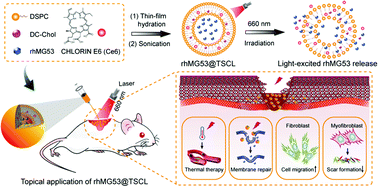A cell membrane repair protein-based nanoformulation with multiple actuators for scarless wound healing†
Abstract
Diabetic wounds remain a major contributor to disability worldwide due to their difficulty of healing, and their primary etiologic factor involves impaired cell membrane repair. Additionally, ideal wound repair should prevent excessive scar formation from affecting tissue function following reconstruction. Therefore, the development of a therapeutic strategy for promoting rapid wound healing and reduced scar formation is urgently needed. In this study, a remote light-controlled thermosensitive nanoformulation was developed, which integrated the photothermal conversion performance of a photosensitizer and cell membrane repair protein (rhMG53). The nanoformulation not only protected rhMG53 from being degraded by proteases at the lesion site but also efficiently released this protein through photothermal stimulation. The nanoformulation remained stable at physiological temperatures and released approximately 80% rhMG53 at 45 °C. More protein was effectively delivered to tissue cells, achieving synergistic therapy with photothermal and rhMG53. By utilizing this approach, increased wound closure rate, reduced extent of cell membrane damage and inflammation, and improved cell function were observed in diabetic wounds. More importantly, rhMG53@TSCL3 treatment inhibited excessive skin fibrosis and angiogenesis, indicating a reduction in scar formation. Collectively, this work reveals a promising strategy for high-quality wound repair and provides a new route for rapid scarless wound healing.



 Please wait while we load your content...
Please wait while we load your content...